Your cart is currently empty!
Author: luckacco@hotmail.com
-
Hans Fleissner
Views: 0
Hans Fleissner’s “Singing” Safety Lamps
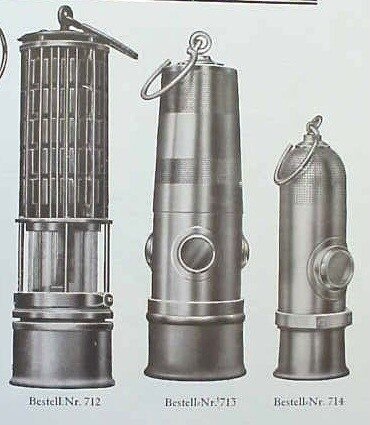
Drawings of Fleissner lamps from 1926 Friemann & Wolf catalogue. Note that while No. 714 is a Fleissner lamp, it is not a “singing” lamp.
The Fleissner lamp, or otherwise know as the “Singing” safety lamp, was the first practical attempt to provide an audible warning from a flame safety lamp in the presence of firedamp. The lamp’s inventor, Hans Fleissner (1881-1928), came from a mining family in Bohemia. He was born in Zwodau near Falkenau-on-Eger, and eventually received a doctoral degree from Prague’s technical university. After World War 1, he was a professor at the famous Leoben Mining University. He died in Karlsbad on June 15, 1928.
Fleissner worked at the Royal Mining Institute at Bruex from 1910 to 1918. At the Royal Mining Institute, he was responsible for investigating methods for preventing firedamp explosions and other dangers in the mines. While at the Royal Mining Institute, Fleissner developed the idea for an audible safety lamp around 1915, and was granted a patent on October 6th, 1916. In the Volume 7, 1917 edition of Bergbau und Hutt, Fleissner describes the principal of his lamp as follows:
“a flame in a certain position within a hollow body, open at both sides, is able to produce a sound if the flame rises due to the presence of firedamp.”

Fliessner’s benzene experimental lamp.
Around 1916, Friemann & Wolf manufactured two experimental “singing” lamps. One was fueled by benzene, while the other was a carbide safety lamp burning acetylene. Fleissner discovered that the benzene model could detect methane from .5 to 5%, and was more sensitive in detecting firedamp than the acetylene model. But, the acetylene model produced a much stronger sound. (The original benzene test lamp can be seen at the German Mining Industry Museum, in Bochum, Germany.)
Fleissner and Friemann & Wolf obviously felt the experimental lamps were a success, and that there was a need for a combination acoustical and optical safety lamp in the European coalmines and in other industries. While many variations were produced, Friemann & Wolf made three (3) distinct, benzene models of Fleissner’s “singing” lamp (Note: the author does not know of any acetylene models in existence). Judging from various Friemann & Wolf catalogues, “singing ” lamps were produced until the early 1930’s.
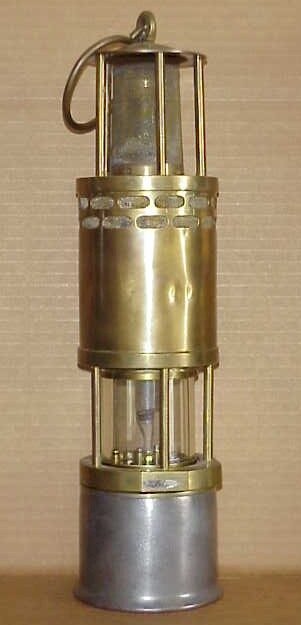
1923 Model. Click to enlarge.
As with most Friemann & Wolf lamps, the engineering and construction of the “singing” lamps were excellent. Judging from patents and advertisements, it appears that the first production model was the 1923 patented design(The author has not been able to identify the Wolf model number for this lamp). Model numbers 712 and 713 apparently came a few years after, possibly in 1925. It is interesting to note that models 712 and 713, while looking very different in design, are similar in regards to the internal design of the sounding system. There are slight differences in the 1923 design, compared with models 712 and 713. While the 712 and 713 were commonly shown together in Friemann & Wolf catalogues, the author has not been able to locate any documentation showing all three models. It is possible that the 1923 model was discontinued around 1926, and not produced concurrently with 712 & 713.

Model Number 712. Click to enlarge.
The 712 design is based off the basic Wolf lamp fitted with a corrugated bonnet, and was probably used for general underground firedamp detection. The 713 is heavy duty, totally enclosed, and fitted with a prism for observing the flame from above the lamp. It was designed for lowering down in holes and low places to measure and detect firedamp. Being totally enclosed, the lamp was well protected from dripping water and bumps from obstructions.

Model Number 713. Click to enlarge.
It is interesting to note that there are a few examples of the 1923 variety that were obviously made for the US market (see advertisement). It is a made of all aluminum, and is tagged similar to other German-made Wolf lamps for the US market. Also, there exists at least one 1923 example with a Wolf-Sheffield brass tag on it. Did the 1923 model end up being used for the export market?
It appears that most of these lamps were used in Eastern Europe, especially in the Austro-Hungarian area. While few made it to the US, there is one variety that targeted the US market. It is a 1923 variety made of all aluminum, and is tagged similar to other German-made Wolf lamps for the US market.
Even though Friemann & Wolf produced many varieties of “singing” lamps for almost twenty (20) years, relatively little information is known today about the development, applications, and performance of Fleissner’s lamps. Many people have explained the rarity of the “singing” lamps as having limited use because under noisy conditions, the lamp’s sound couldn’t be heard. While this might explain its limited use, there must have been a distinct niche for this type of lamp judging from the length of production and number of models and variations. The complete story of Fleissner’s “singing” lamp has yet to be told. Much of it probably has been lost to time.
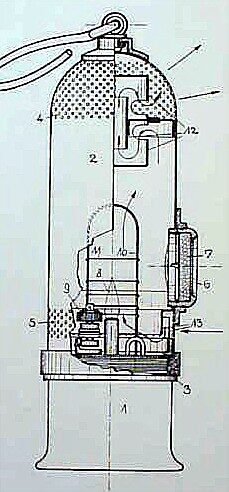
No. 714. Fleissner’s non-“singing” lamp.
While Fleissner is best known for his acoustic-optical safety lamp, he did patent another safety lamp design that was also produced by Friemann & Wolf and was designated as model 714. While the 714 looks like a small version of Wolf’s 713 lamp, it is not a “singing” lamp. It is more like a “baby” version of the Beard-Mackie sight indication system. The lamp is designed with a ladder system with platinum wires located over the burner. The lamp also has an unusual gauze cooling system that appears to have designed to dampen the velocity of the burnt gas within the lamp.

For additional photos and information, click on thumbnails below!



References:
Wolf-Fleissner ” Singing” Safety Lamps, Manfred Stutzer, Eureka!, January 1995, Issue 13.
-
New Page 1
Views: 0
Wolf’s Dahlmann Lamp
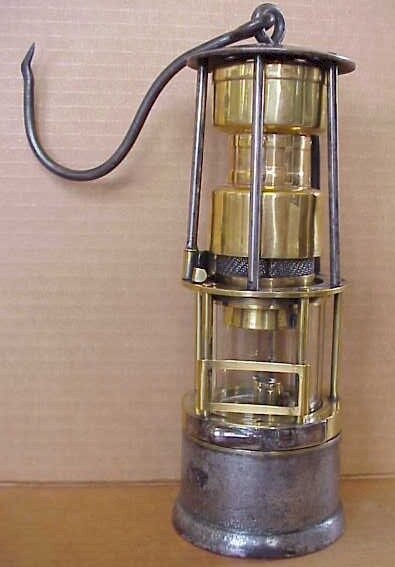
Click on picture to enlarge
The Friemann & Wolf Company of Zwickau, Germany made many unusual styles of safety lamps prior to 1900. One of the more unusual lamps, and short lived, was a lamp known as the Dahlmann. Wolf must of thought a lot of the lamp, because it appeared as a centerpiece in some pre-1900 advertisements. But the lamp disappeared from the advertisements and Wolf’s catalogues going into the 20th century. In fact, very few have survived.
The Dahlmann was first patented on May 23, 1894 and was designed for gas testing/measuring. Basically, the design is a Museler chimney system with a damping
 system to control the air intake. The damper consists of a brass sheet metal cylinder with a wire gauze top. It works by sliding the cylinder up or down, which adjusted the amount of intake gauze area that is exposed to the atmosphere. A device on one of the standards gages the adjustment of the damper. There are essentially three positions for the damper: 1) fully open, 2) half open, and 3) fully closed (lamp will extinguish). Mounted on two of the lower standards is a sighting device for measuring the flame.
system to control the air intake. The damper consists of a brass sheet metal cylinder with a wire gauze top. It works by sliding the cylinder up or down, which adjusted the amount of intake gauze area that is exposed to the atmosphere. A device on one of the standards gages the adjustment of the damper. There are essentially three positions for the damper: 1) fully open, 2) half open, and 3) fully closed (lamp will extinguish). Mounted on two of the lower standards is a sighting device for measuring the flame.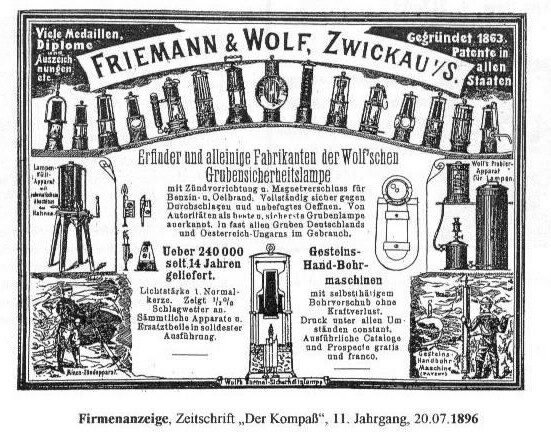
Click on picture to enlarge
The example pictured has an early 1893 spring loaded type striker. The serial number is 194,442, which puts the lamp circa 1895 or 1896. Another example exists in the German Mining Museum in Bochum. Interestingly, the one at Bochum is only ten (10) serial numbers off th example shown.
-
Initial Homepage
Views: 0

Mine Locomotive Carbide Safety Lamp. Made by Wilhelm Sieppel, Bochum, Germany. Circa 1910. Click photo for more images.
Buy, Sell, or Trade. Will buy one specimen, or entire collection. Free Appraisals
Hello!! My name is Dave Gresko, and welcome to my homepage. I have been buying, selling, trading, and collecting antique miner’s lighting devices for the past 25 years. Presently, I mainly focus on rare and unusual miner’s safety lamps. Do you have any? If so, I would like to hear about them. Just send me an email with a photo, and I will see if I can provide information on your lamp!

1915 JUSTRITE METAL ADVERTISEMENT SIGN
A few years ago, I was lucky to find an original 1915 Justrite metal advertisement sign that was hung in hardware stores where Justrite miner’s carbide lamps were
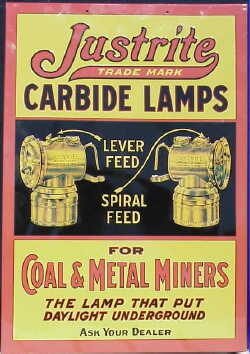 sold. There are so few of the originals left, so I decided to reproduce the sign in a limited quantity. Produced under an agreement with Justrite Co. (which is still in business, although not making mine lamps anymore!), this sign is a beautiful, fully embossed metal, three-color lithograph. It measures 11 1/2″ by 16 1/2″ and is suitable for framing.
sold. There are so few of the originals left, so I decided to reproduce the sign in a limited quantity. Produced under an agreement with Justrite Co. (which is still in business, although not making mine lamps anymore!), this sign is a beautiful, fully embossed metal, three-color lithograph. It measures 11 1/2″ by 16 1/2″ and is suitable for framing.This sign will compliment any mining artifact collection!!!!
(click sign to enlarge)
The cost of the sign is $49, which includes postage. To order, E-mail me at davegresko@minerslamps.net.

“Red Edge Shovels“
Hardware Store Advertisement Metal Sign

The “Red Edge” shovel was made by the Wyoming Shovel Works, in the heart of coal country, in Wyoming, PA. Wyoming Shovel Works made several types of shovels and picks, and painted
the edges of their tools red to differentiate from competitors.This sign is quite rare, since there are few metal advertisement signs that depict an underground miner. Since the sign was intended for display in hardware stores back when miner’s had to purchase their own tools, the vintage is probably 1920’s.
I have reproduced a limited number of these signs for collectors of mining
artifacts. Utilizing computer aided imaging and high-quality silk-screening, it is almost identical to the original. It measures 18″ X 12″, and would be an excellent display item for any mine artifact collection.
The cost of the sign is $35 plus $5 postage. You can email me at davegresko@minerslamps.net to order yours. Satisfaction is guaranteed.
-
ChesneauPic
Views: 0
Chesneau Lamp
This Chesneau lamp is of German make and marked “Wilhelm Seippel Gruben-Sicherheitslampen & Maschinenfabrik BOCHUM i.W.” This particular example is unfired. The main difference between French and German built Chesneaus is that the German lamps have a fabricated font, while the French lamps have a heavy cast font. Dating this lamp is difficult. It was probably made between 1910-1930, but even post W.W.II might be possible.
Back
-
Arras Chesneau
Views: 0






BACK
-
Ashworth1
Views: 0
Ashworth-Hepplewhite-Gray Lamp
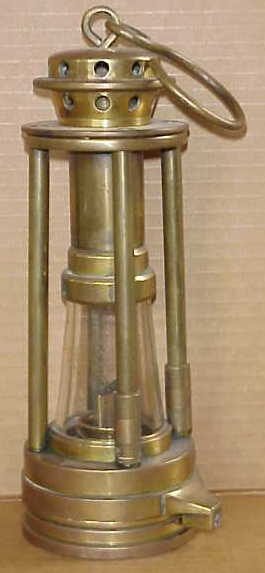
A-H-G Lamp made by Davis of Derby. Early design with straight standards and no middle supporting disc. The workmanship on this lamp is superior compared to later versions. It shows that these particular lamps were not mass produced like lamps used for regular lighting. Circa 1895.
Back
-
Mine Locomotive Safety Lamps
Views: 0
Mine Locomotive Safety Lamps
Some of the rarest miner’s safety lamps are those that were made for underground mine locomotives. Although both Friemann & Wolf and Wilhelm Seippel made various models, only a few exist in collections and museums today. Because these lamps were fairly large, and put on a moving piece of machinery, no doubt they had a short life span. Judging from manufactures’ catalogues, locomotive safety lamps do not appeared to have made it past 1920. This was when safer, more reliable, and heavy-duty electric accumulator lamps were becoming popular.
The lamps above were made by Wilhelm Seippel, Bochum, Germany. The one to the left used benzine for fuel, while the one to the right was fueled by carbide. Both are pre-1910.

For a closer look, click on the images below:


-
Safety Lamp Banner
Views: 0








